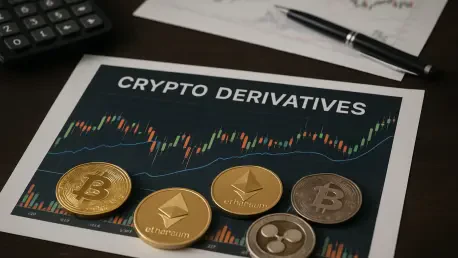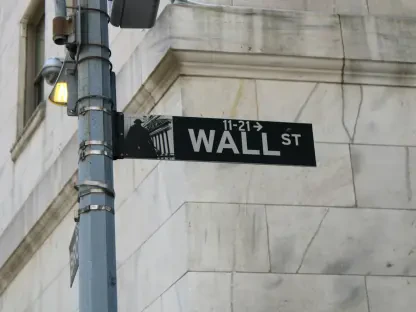The cryptocurrency market has hit a remarkable milestone with the open interest in derivatives for major digital assets like Bitcoin, Ethereum, and XRP surging to an astonishing $145 billion, representing a seismic shift in perception. This figure isn’t just a statistic—it signals that cryptocurrencies are transforming from volatile, speculative bets into credible financial instruments embraced by institutional players. As traditional finance begins to integrate these assets through regulated platforms, the crypto space is maturing at an unprecedented rate, paving the way for greater stability and accessibility. This surge in derivatives activity signals a turning point, where digital currencies are no longer fringe investments but are increasingly aligned with mainstream markets. For investors, this opens up a spectrum of opportunities, from the relative safety of established coins to the high-stakes potential of emerging altcoins. The implications of this $145 billion benchmark are profound, reshaping how the world views and interacts with the crypto ecosystem in a way that could redefine financial markets for years to come.
Institutional Surge Transforms Crypto Landscape
The staggering $145 billion in open interest across Bitcoin, Ethereum, and XRP highlights a dramatic rise in institutional involvement that is redefining the cryptocurrency arena. Bitcoin alone accounts for $82.5 billion, Ethereum contributes $55 billion, and XRP adds $7.5 billion to this total, reflecting a flood of capital from major financial players. Regulated platforms such as the Chicago Mercantile Exchange (CME) are at the forefront, reporting record-breaking volumes in futures and options contracts. This institutional influx brings much-needed liquidity to the market, smoothing out the erratic price movements that have long deterred conservative investors. As hedge funds, asset managers, and corporate treasuries dip their toes into crypto derivatives, the market is gaining a level of credibility that was previously elusive. This shift is not just about numbers—it’s about trust, as traditional finance begins to see digital assets as viable components of diversified portfolios, fundamentally altering the risk profile of the entire sector.
Beyond the raw figures, this institutional wave is fostering an environment where cryptocurrencies are treated with the same rigor as stocks or commodities. The presence of big players on platforms like CME ensures tighter oversight and better risk management, which in turn attracts even more cautious capital. This creates a virtuous cycle: as more institutions participate, market depth increases, further stabilizing prices and encouraging broader adoption. Unlike the early days of crypto, when retail speculation drove wild swings, today’s market is increasingly shaped by strategic, long-term bets from sophisticated investors. The $145 billion open interest is a clear indicator that the barriers between traditional finance and digital assets are crumbling, setting the stage for a more integrated financial ecosystem. For those watching the space, this represents not just growth, but a structural evolution that could anchor cryptocurrencies as a permanent fixture in global markets.
Distinct Forces Behind Major Cryptocurrencies
Bitcoin, Ethereum, and XRP each contribute uniquely to the derivatives boom, reflecting diverse drivers that fuel the $145 billion open interest milestone. Bitcoin, holding the lion’s share, is increasingly regarded as a mature asset class, with analysts projecting a potential market value of $10 trillion as derivatives activity accelerates. Its dominance is underpinned by a growing perception of it as a store of value, akin to digital gold, especially among institutional investors seeking hedges against inflation. Meanwhile, Ethereum stands out for its versatility, functioning both as a financial asset and a programmable blockchain that powers decentralized applications. Corporate interest and accessible micro contracts on regulated exchanges like CME amplify its appeal, drawing in a wide range of participants. These distinct characteristics highlight how Bitcoin and Ethereum cater to different investor needs, yet both solidify their roles as cornerstones of the crypto derivatives market.
On the other hand, XRP has emerged as a surprising contender, achieving a $1 billion open interest on CME faster than any other asset, despite its polarizing reputation. Speculation around a potential U.S. ETF approval has ignited interest, driving rapid growth in derivatives contracts even amid ongoing debates about its market position. This swift ascent underscores the appetite for assets with high speculative potential, even when accompanied by uncertainty. Unlike Bitcoin’s stability or Ethereum’s utility, XRP’s derivatives surge is fueled by a mix of optimism and controversy, illustrating the diverse motivations behind investor behavior in this space. Together, these three cryptocurrencies paint a picture of a market where established giants and contentious underdogs alike can thrive through derivatives, offering a spectrum of risk and reward. This dynamic showcases the maturing crypto landscape, where unique value propositions drive participation across varied asset profiles.
Derivatives as a Stabilizing Mechanism
One of the most transformative aspects of the $145 billion open interest in crypto derivatives is their role in curbing the market’s infamous volatility. By allowing investors to hedge positions and spread risk across larger liquidity pools, derivatives create a buffer against the dramatic price swings that once defined cryptocurrencies. This stabilization is crucial for institutional players who prioritize predictability over speculative gains, making digital assets more palatable to risk-averse entities like pension funds and corporate treasuries. As futures and options contracts grow in volume on platforms like CME, they distribute market exposure more evenly, preventing sudden crashes or spikes driven by retail panic or hype. This shift marks a departure from the wild west era of crypto trading, aligning these assets more closely with traditional financial instruments and enhancing their legitimacy in the eyes of mainstream finance.
Moreover, the stabilizing effect of derivatives extends beyond price dynamics to influence broader market perception. As volatility decreases, cryptocurrencies shed their reputation as gambling tools and gain traction as serious investment vehicles. This is evident in the increasing participation of traditional financial institutions, which view derivatives as a gateway to managing crypto exposure without the full brunt of spot market risks. The $145 billion open interest is not just a measure of market activity but a testament to how derivatives are reshaping investor confidence, turning skepticism into strategic engagement. For the crypto market, this means a more sustainable growth trajectory, where sharp corrections are less likely to derail progress. As this trend continues, the integration of digital assets into conventional portfolios becomes not just feasible, but a logical step for diversification, signaling a new chapter of maturity for the industry.
Rising Altcoins Amid Giants
While Bitcoin, Ethereum, and XRP dominate the derivatives landscape, emerging altcoins like MAGACOIN FINANCE are capturing attention as high-potential investments within this $145 billion market. With a smaller market footprint, this lesser-known token offers a different kind of opportunity—one where even modest capital inflows could lead to substantial price movements, echoing the early, explosive growth phases of Bitcoin. Analysts have noted a growing buzz around MAGACOIN FINANCE, positioning it as a speculative play for those willing to embrace elevated risks in pursuit of outsized returns. Unlike the stability offered by major cryptocurrencies, this altcoin represents the frontier of crypto investing, where volatility can be a double-edged sword. For investors seeking diversification beyond the established giants, such emerging assets provide a chance to tap into nascent trends before they hit the mainstream radar.
The appeal of altcoins like MAGACOIN FINANCE lies in their potential to disrupt the status quo, much like early cryptocurrencies did before institutionalization took hold. Their smaller scale means that market dynamics can shift rapidly, offering both opportunity and uncertainty in equal measure. This contrasts sharply with the more predictable trajectories of Bitcoin and Ethereum, highlighting a broader trend of investor diversification across the crypto spectrum. As the derivatives market expands, it accommodates not only the heavyweights but also these under-the-radar tokens, reflecting a maturing ecosystem that caters to varied risk appetites. The $145 billion open interest milestone thus encapsulates a dual narrative: the anchoring presence of major assets and the speculative allure of emerging ones. For market participants, this diversity underscores the importance of balancing safe, long-term holdings with riskier bets, ensuring a comprehensive approach to navigating the evolving digital asset landscape.
Crypto’s Path to Mainstream Integration
The $145 billion open interest in crypto derivatives marks a defining moment in the journey toward mainstream acceptance, driven by integration into regulated financial systems. Platforms like CME have become central hubs for institutional activity, offering a structured environment that builds trust among traditional investors. This shift is not merely transactional—it’s cultural, as cryptocurrencies transition from niche experiments to recognized components of global finance. Analysts widely agree that derivatives are more than speculative tools; they are mechanisms for risk management that align digital assets with conventional markets. As liquidity grows and price volatility diminishes, the barriers that once kept institutional capital at bay are eroding, paving the way for broader adoption across sectors. This trend signals a market in transition, where crypto’s once-rebellious image is giving way to a more disciplined, integrated reality.
Looking deeper, this mainstreaming reflects a convergence of investor strategies, from the stability of Bitcoin and Ethereum to the speculative edge of altcoins like MAGACOIN FINANCE. The derivatives market accommodates this spectrum, enabling participants to tailor their exposure based on risk tolerance and investment goals. Bitcoin and Ethereum provide a foundation for long-term value, backed by institutional confidence and technological innovation, while emerging tokens cater to those chasing high-growth opportunities. The $145 billion benchmark encapsulates this diversity, illustrating how far the crypto space has come in gaining legitimacy. As regulated platforms continue to bridge the gap between traditional and digital finance, the market’s evolution suggests a future where cryptocurrencies are not outliers but integral parts of investment portfolios. This ongoing transformation invites careful consideration of both established and speculative assets as the industry charts its path forward.









